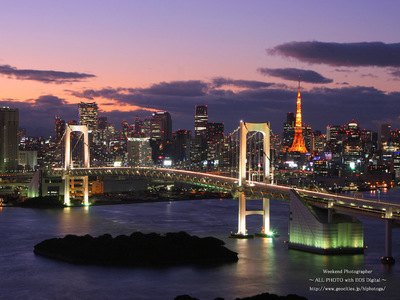
Unseen Tokyo Three Hidden Sides of theJapanese Metropolis
融合传统与前卫的东京新体验
FUMIE KIM, FORMER CNN INTERN
CNN前实习记者 金文惠
My name is Fumie Kim. I'm a former internCNN. We are now at Kagurazaka. It is a very local place. You'll never find thisplace in any kind of guidebook. Believe it or not, this neighborhood used to bemuch bigger than Ginza or Shinjuku or Shibuya.
我是金文惠,CNN的前实习记者。我们现在在神乐圾。这是个地方色彩非常浓厚的地方。你绝不会在任何一本旅游指南里找到这样的景点。信不信由你,这儿的邻近区域以前比银座、新宿或涩谷还要大许多。
This is the famous shrine in Kagurazaka.This is the red shrine. Back then there used to be a lot of geishas,entertainers, performers came to this shrine and said their prayers.
这是神乐板有名的神社。这是座红色的神社。以前常常有许多艺伎、艺人、表演者来这座神社并且祈祷。
REMO CAMEROTA, GRAFFITI ARTIST
涂鸦艺人雷莫·卡悔罗塔
I came from Australia three years ago to doa book called Graffiti Japan. I'm a photographer and graffiti artist.
为了完成一本名叫《涂鸦日本》的书,我三年前从澳大利亚来到这里。我是位摄影师,也是位涂鸦艺术家。
I would imagine they probably got a coupleof thousand dollars to paint, but often the graffiti artists do it for free aswell, because they're gonna get their work up big in front of everyone inTokyo.
我会想象他们可能为了数千美元而作画,但这些涂鸦艺术家也常常无偿作同,因为他们将在东京的每个人面前展示他们的画作。
In japan there are two types of graffitiwork. You've got the guys who go out bombing and doing it illegally,and thenyou've got the commissioned graffiti work, pieces like this where you can...you only have to look at it and realize it is actually a serious... uh, an artform. This kind of stuff is done by professionals and this kind of work takesyears to accomplish, and that's the difference between people bombing thestreets and just writing their name.
在日本有两种涂鸦画。有一些人在户外您意非法涂鸦,也有一些接受委托而创作的涂鸦作品,这样的作品是……你只需看过一眼便知道它的确是个认真的……嗯,艺术作品。这样的画作由职业画家完成,并且需要数年才能够完成,那便是和街头,您意涂鸦签名的不同之处。
There's definitely a cultural buzzhappening here which it seems like... it almost seems like the center of theworld for creativity.
这里显然激荡出了文化火花,这有点像……这几乎就像是汇集创意的世界中心。
JULIAN WORRAL, ARCHITECT
建筑师朱利安·沃勒尔
Omotesando is essentially Tokyo's fashionparade. It's a gigantic catwalk for the fashionable and the sophisticated inthe city. You've got the global brands all lining up and down this boulevard.This is the main drag, the main boulevard, but just behind the first row ofbuildings-just in the back streets here-you find a completely different world.It's a much more intimate network of little lanes, quirk shops, cafés. So, it'sa much more kind of human quality in the back streets.
表参道可以说是东京的时尚街。对于这座城市中时髦的人和熟悉时尚的人而言,这里就像是超大的伸展台。这条大道上处处可见全球知名品牌。这是主要的、最繁华的街道,但在第一排建筑物之后,仅在这里的小巷弄中,你就会看到一个完全不同的世界。这里有由小巷、奇特店铺和咖啡店所构成的紧密交织的网络。所以,小巷弄中多了许多人文的气息。
Tokyo's an interesting place to livebecause the buildings are always changing, I mean much more rapidly than in anyother city I've been in. It's almost like they're disposable, but the patternof that change seems to be rather stable. 50, it's like a river. You're seeingthe water rushing by all the time, but the river is always there. That's reallythe best way I can think of the experience of being in Tokyo. It's like it'scontinually changing, but it's somehow eternally the same.
东京是座很有趣的居住城市,因为建筑物总是瞬息万变,它的改变比我所待过的其他城市都要快。这感觉就像它们是可抛弃的一般,但是改变的模式似乎相当稳定。所以,这就像是河流。你随时都可看到河水流动,但是河流却一直在那里。那是我能想到用来形容东京生活经验的最棒说法。它好像不停地在改变,但却始终如一。
Mostly the city looks kind of random andChaotic,but if you get down to the human scale, it actually gets verysensitive and quite responsive. It's a kind of a model of what a 21st centurycity could be. It feels traditional but also very, very modern, verycontemporary. And it's actually much more comfortable to live in than I thinkmany people who haven't visited Tokyo might expect.
这座城市大多时候看起来有点随兴且混乱。但是如果你留意人性的层面,它其实是相当敏锐且热情的。它是21世纪城市的一个典范。它相当传统但也非常现代,非常当代。我觉得它实际上住起来会比从未造访过东京的人所期望的还要舒适。
The Japanese sometimes use the word nurui,which means lukewarm. It's like a bath that's not too hot, it's not too cold.It's very comfortable to be in. And in fact, many people never leave.
日本人常常用nurui这个词,它的意思是微温的。它就像是不会太烫也不会太冷的洗澡水。待在这里很舒服自在。事实上,许多人从未离开过。











